
Patsy Ruth Miller was an American film actress who played Esméralda in The Hunchback of Notre Dame (1923) opposite Lon Chaney.
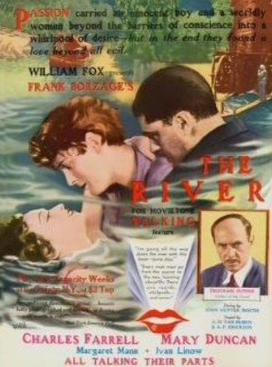
The River is a 1929 sound part-talkie drama film directed by Frank Borzage, and starring Charles Farrell and Mary Duncan. In addition to sequences with audible dialogue or talking sequences, the film features a synchronized musical score and sound effects along with English intertitles. The soundtrack was recorded using the Movietone sound-on-film system. Much of the film has been lost. A reconstructed version with the about 45 minutes of surviving film, using still images and explanatory titlecards to bridge the missing scenes, was produced by the Munich Filmmuseum, in collaboration with the cinémathèques of Switzerland and Luxembourg. This version was screened in 2006 by the American Museum of the Moving Image in New York City. Borzage also directed Farrell, opposite Janet Gaynor, in Seventh Heaven (1927), Street Angel (1928), and Lucky Star (1929) during this period.

The Girl on the Barge is a 1929 American sound part-talkie drama film directed by Edward Sloman and starring Jean Hersholt and Sally O'Neil. In addition to sequences with audible dialogue or talking sequences, the film features a synchronized musical score, singing and sound effects along with English intertitles. The sound was recorded using the Western Electric Sound System process. The film was produced and distributed by Universal Pictures. The film was filmed in Whitehall, NY. The town is looking for a copy of the movie but it appears to no longer be extant.
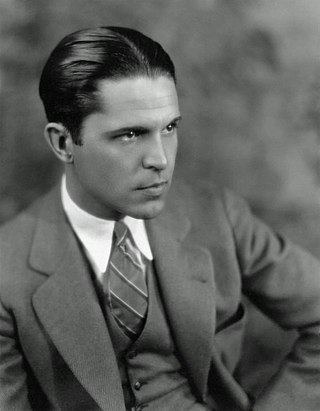
Malcolm McGregor was an American actor of the silent era. McGregor appeared in more than 50 films between 1922 and 1936. He was born in Newark, New Jersey and died in Hollywood, California.

The Aviator is a 1929 American Pre-Code Vitaphone comedy film produced and released by Warner Bros. Directed by Roy Del Ruth, the film was based on the play of the same name by James Montgomery and stars Edward Everett Horton and Patsy Ruth Miller. The Aviator is similar to the silent comedy The Hottentot (1922), where a hapless individual has to pretend to be a famous steeplehorse jockey. The Aviator today is considered a lost film.

Seven Footprints to Satan is a sound part-talkie 1929 American mystery film directed by Danish filmmaker Benjamin Christensen. Based on the 1928 story of the same name by Abraham Merritt, it stars Thelma Todd, Creighton Hale, William V. Mong and Sheldon Lewis. In addition to sequences with audible dialogue or talking sequences, the film features a synchronized musical score and sound effects along with English intertitles. The film survives at the Cineteca Italiana in an alternate sound version known as an International Sound Version. The sound disks for this foreign sound version are apparently not extant.
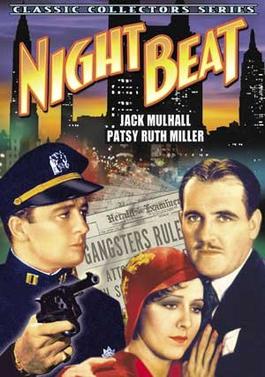
Night Beat is a 1931 American pre-Code crime film directed by George B. Seitz.
Harry David Kerr was an American songwriter, lyricist, author, and lawyer. Kerr became active in music at age 15 (1895). The practice of law had been his prime avocation until 1920, when he decided to focus on songwriting. But he still continued to use his legal training in music. In 1922, while living in New York City, Kerr prepared the incorporation documents for the American Society of Composers, Authors and Publishers (ASCAP), of which he had become one of 90 charter members at its founding in 1914.
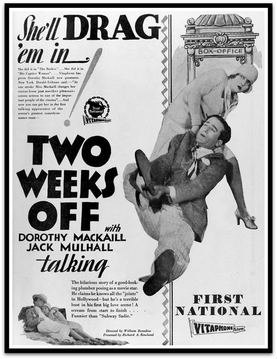
Two Weeks Off is a 1929 American sound part-talkie comedy film directed by William Beaudine. In addition to sequences with audible dialogue or talking sequences, the film features a synchronized musical score and sound effects along with English intertitles. The soundtrack was recorded using the Vitaphone sound-on-disc system. A complete nitrate print survives at UCLA.

The Hottentot is a lost 1929 American all-talking sound pre-Code comedy film directed by Roy Del Ruth and starring Edward Everett Horton and Patsy Ruth Miller. It is based on the 1920 Broadway play The Hottentot by William Collier, Sr. and Victor Mapes.

Tropical Nights is a 1928 American silent drama film directed by Elmer Clifton and starring Patsy Ruth Miller, Malcolm McGregor and Ray Hallor. It is based on the Jack London story A Raid on the Oyster Pirates.

One Stolen Night is a 1929 American sound part-talkie adventure crime film directed by Scott R. Dunlap, and starring Betty Bronson, William Collier Jr., Mitchell Lewis, Harry Todd, and Charles Hill Mailes. In addition to sequences with audible dialogue or talking sequences, the film features a synchronized musical score and sound effects along with English intertitles. The soundtrack was recorded using the Vitaphone sound-on-disc system. The film is based on the short story The Arab by D. D. Calhoun. It is a remake of the 1923 film with the same name. The film was released by Warner Bros. on March 16, 1929.
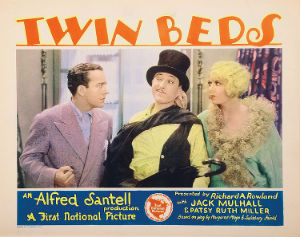
Twin Beds is a 1929 American comedy film directed by Alfred Santell and written by F. McGrew Willis. It is based on the 1914 play Twin Beds by Edward Salisbury Field and Margaret Mayo. The film stars Jack Mulhall, Patsy Ruth Miller, Edythe Chapman, Knute Erickson, Jocelyn Lee and Nita Martan. The film was released by Warner Bros. on July 14, 1929.

The Sap is a 1929 American sound part-talkie comedy film directed by Archie Mayo and written by De Leon Anthony and Robert Lord. In addition to sequences with audible dialogue or talking sequences, the film features a synchronized musical score and sound effects along with English intertitles. The soundtrack was recorded using the Vitaphone sound-on-disc system. The film is based on the 1924 play The Sap by William A. Grew. The film stars Edward Everett Horton, Alan Hale Sr., Patsy Ruth Miller, Russell Simpson, Jerry Mandy and Edna Murphy. The film was released by Warner Bros. on November 9, 1929. This film was the last "part-talkie" produced by the studio.

Molly and Me is a 1929 sound part-talkie American comedy film directed by Albert Ray. In addition to sequences with audible dialogue or talking sequences, the film features a synchronized musical score and sound effects along with English intertitles. The soundtrack was recorded using the Tiffany-Tone sound system. The film stars Belle Bennett, Joe E. Brown and Alberta Vaughn.

Two Men and a Maid is a 1929 American sound part-talkie romantic drama film directed by George Archainbaud and starring William Collier Jr., Alma Bennett and Eddie Gribbon. In addition to sequences with audible dialogue or talking sequences, the film features a synchronized musical score and sound effects along with English intertitles. The soundtrack was recorded using the Tiffany-Tone sound-on-film system using RCA Photophone equipment.

New Orleans is a 1929 American sound part-talkie drama film directed by Reginald Barker and starring Ricardo Cortez, William Collier Jr., Alma Bennett. In addition to sequences with audible dialogue or talking sequences, the film features a synchronized musical score and sound effects along with English intertitles. The soundtrack was recorded using the Tiffany-Tone sound-on-film system using RCA Photophone equipment. The film was produced and distributed by the independent Tiffany Pictures.

My Lady's Past is a 1929 American sound part-talkie drama film directed by Albert Ray and starring Belle Bennett, Joe E. Brown and Alma Bennett. In addition to sequences with audible dialogue or talking sequences, the film features a synchronized musical score and sound effects along with English intertitles. The soundtrack was recorded using the Tiffany-Tone sound-on-film system using RCA Photophone equipment. After completing his first novel, a writer abandons his wife for his secretary. The film survives at BFI/National Film And Television Archive.

Midstream is a 1929 American sound part-talkie science fiction film directed by James Flood and starring Ricardo Cortez, Claire Windsor, and Montagu Love. In addition to sequences with audible dialogue or talking sequences, the film features a synchronized musical score and sound effects along with English intertitles. The soundtrack was recorded using the Tiffany-Tone sound-on-film system using RCA Photophone equipment.
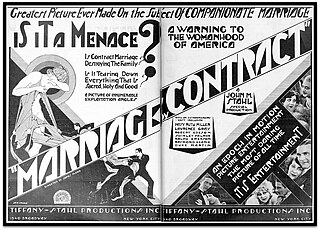
Marriage by Contract is a 1928 American sound part-talkie drama film directed by James Flood and starring Patsy Ruth Miller, Lawrence Gray and Robert Edeson. In addition to sequences with audible dialogue or talking sequences, the film features a synchronized musical score and sound effects along with English intertitles. The soundtrack was recorded using the Tiffany-Tone sound-on-film system. This film was one of the first sound films produced by Tiffany Pictures, one of the largest independent studios in Hollywood at the time, and was followed by Lucky Boy.



















